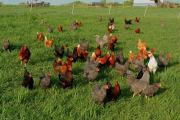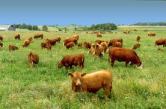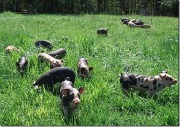Organic, Free Range, Grass Fed, Air chilled, Natural. These are the terms we see listed on everything that we consume. For the sake of not wanting this post to be a novel, I’m going to stick to meat and eggs.
One of the most important things I think about when I buy food for my family is knowing where my food comes from. I am a HUGE advocate for shopping locally and supporting the farmers in my community. Make it a point to visit farmer’s markets and small family-owned natural grocery stores. Not only will you have the opportunity to ask questions about their practices, but you will actually get to meet the person who fed and loved the animals and picked the eggs out of the hen house. In our world of mega-stores and chain-grocers, it is far too easy to forget how important this is. I mean, it’s what you feed your children and nourish your body with. Shouldn’t our foods origins be of the utmost importance?
That being said, let’s get into the nitty-gritty of meat and egg labels.
Organic:
USDA regulations mandate that livestock, including chicken, labeled “organic,” must be allowed “access to pasture” during raising. This requirement includes “access to the outside, direct sunlight, fresh air and freedom of movement.” This is a start, and far better than the mass-produced brands that house their chickens, cows, and pigs in small barns and pump them full of antibiotics. The important thing for Paleo followers to think about is that organic does not mean pasture roaming. Organic animals are fed a vegetarian diet of grains, corn, and soy beans. As the post is titled, you are what you eat. Trace amounts of inflammatory grains and gluten pass through the meat of these animals.
Free Range:
This is something you will frequently see on eggs and chicken. USDA standards require that producers of “free-range” chicken “demonstrate that the poultry has been allowed access to the outside” during raising. However, free-range regulations do not elaborate on a given amount of daily time during which the chickens must be “allowed access” to the outdoors, or the size of the outdoor space they may roam. This makes the term “free-range” inherently ambiguous without a more substantive description of the conditions in which chickens were raised. Under the regulatory language, all organic chickens are raised under generic free-range conditions. However, free-range chicken does not necessarily qualify as an organic food product.
Air Chilled:
This is a term you will see listed on chicken packaging. The conventional way for poultry producers to cool the chicken down after slaughter is to dunk them in to chlorinated ice water, this helps to lower the temperature and kill any bacteria. Air chilled chicken is put into a climate controlled chamber and left to cool down in a humid cold room. The following is the process that Bell & Evans describes on their website:
Our system consists of three different cooling chambers; each is closely monitored to maintain a specific temperature and humidity during the process. To assure proper chilling, the birds traverse almost two miles of track, taking them over 2 hours and 45 minutes to move through the system. Unlike other Air Chill chambers, ours has a unique, single level chilling line that prevents cross contamination from birds on higher tracks dripping onto those underneath.
This slow chill process is also more effective in tenderizing the meat. Since our chickens do not depend on ice water for chilling, the chicken’s natural juices are not diluted in, or replaced by the water in a conventional water chiller. While in these conventional chillers, chickens may absorb 7 to 8% of their body weight in added water – and that water may contain chlorine. (Chlorine is added to conventional chillers to inhibit bacterial growth.) This water “weeps” out of the meat and is trapped in the “diaper” you find in fresh chicken packaging.
Our birds come out of the Air Chill System with an internal temperature under 35ºF without freezing. With more tender meat and a great symmetrical shape, our Air Chill System gives you a cleaner, better tasting chicken.
Grass Fed/ Pasture Raised:
Cattle raised on a primarily foraged diet are termed grass-fed or pasture-raised; meat or milk may be called grass-fed beef or pasture-raised dairy. However, the term “pasture-raised” can lead to confusion with the term “free range”. Per USDA standards, grass-fed beef are required to have 95% of the diet be pasture foliage. Due to the high-Omega 3 content in their diet, grass-fed beef is higher in naturally occurring Omega 3s, and lower in saturated fat.
Natural:
This term, in my opinion, means nothing. There is very little USDA regulation on this label, and the meat does not have to be free of antibiotics or fed any kind of organic diet. It can be fed pretty much anything as long as it is deemed “natural” in origin. The only thing the “natural” food label protects you from is growth hormone.
The food industry is full of manipulating labels and misleading terms, and the USDA & FDA don’t always have our best interests in mind. I know I have already said this, but please, support your local farmers. In the end they are our lifeline as a nation. Know as much as you can about what you put into your mouth. After all, you are what you eat.



